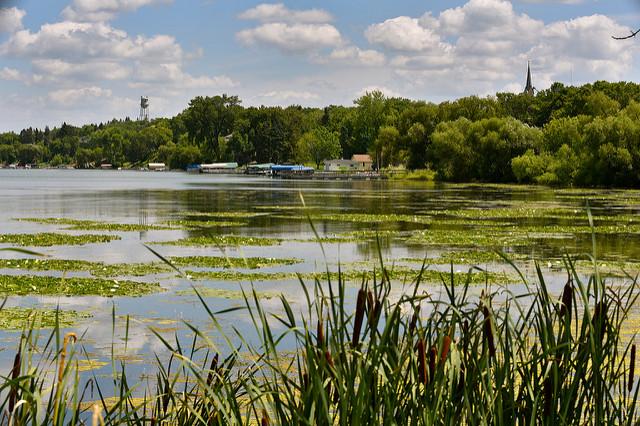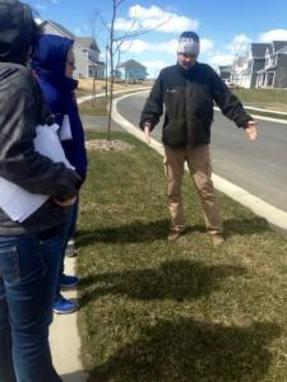By Bridget Roby
As the issue of water quality has surfaced in national dialogue following the Flint, Mich. crisis, communities in Carver County, Minn. are in the midst of more than a half dozen collaborative projects aimed at improving the protection, management, and conservation of their own bodies of water. With more than 30 lakes, a rapidly growing population, and intensive agricultural activity within its borders, maintaining clean, sustainable water sources is no easy job.
The projects are part of the Resilient Communities Project partnership between Carver County and the University of Minnesota, and they range in focus from water quality education to best management practices for reducing lake contamination. But the students working on the projects are not all environmental studies majors. In fact, none are. Instead, they’re studying public policy, horticulture, engineering, and education and human development.
According to Nate Kabat, a Carver County planner and the lead County organizer of the yearlong partnership with RCP, the interdisciplinary nature of the projects is part of their strength.
“Examining water management topics in a multidisciplinary way acknowledges the complexity of water and its importance as an essential community resource,” Kabat said. “Gaining insight from multiple perspectives helps to drive innovation and develop more holistic solutions to best manage this precious resource.”
More than two dozen students from four University departments are working to do just that. And according to Tim Sundby, one of the project leads and a water resources technician for the Carver County Water Management Organization (CCWMO), their work is making a difference.
“The RCP process has been very useful in helping the County prioritize its resources and in creating more effective projects, requirements, and understanding by those involved,” Sundby said. “With the RCP projects that I have been a part of, all of these are important in meeting the State-defined tasks for the CCWMO.”
Countywide water management initiatives
Several projects this year are focused on water management at the county level. As the field of storm water management rapidly evolves, graduate students in the Department of Civil, Environmental, and Geo-Engineering are working to provide the CCWMO recommendations on how best to fine-tune its rules and guidelines regarding storm water reuse.
Historically, the goal of managing storm water was to move it off the landscape quickly and reduce the risk of flooding. Today, however, efforts are focused on keeping water where it falls in order to minimize the amount of pollution reaching lakes, rivers, and streams, and to replenish local ground waters.
Lilly Rouillard, one of the students in Professor John Gulliver’s Urban Hydrology and Water Quality course who is working on the project, said her team is currently researching the soil in the area to determine how much rainwater it can infiltrate and retain as storage. The group is also working to determine the size of a typical storm in Carver County so they know how much water storage local systems should be designed to manage.
Yet keeping storm water pollutants out of local lakes, rivers, and streams is only a piece of the puzzle. The CCWMO also works to minimize the spread of invasive species such as zebra mussel and spiny water flea, which can disrupt the local aquatic ecosystem. During the fall semester, masters students in a Humphrey School of Public
Policy course on program evaluation created a plan for evaluating the CCWMO’s boat inspection program aimed at reducing the spread of non-native species.
The team of students ultimately recommended three primary data collection instruments to assess boaters’ perceptions of the inspection process and its ability to slow the spread of invasive species. The tools are also designed to help determine what changes can be made to improve the inspection process for both boater and inspectors.
Madeline Seveland, the education coordinator for the CCWMO and the lead on this project, said CCWMO staff have reviewed the students’ evaluation plan and are working quickly to put it in place before the summer season.
“This is a newer program and we are interested in making sure it is as effective as possible,” she said.
Targeted initiatives to protect local lakes
Two local bodies of water in Carver County—Lake Waconia and the Grace Chain of Lakes—stand out as the focal point of projects aimed at reducing phosphorus contamination.
Phosphorus is a naturally occurring element that stimulates plant growth, and therefore is a popular ingredient in fertilizers. Yet when run-off and erosion from agricultural fields and fertilized lawns and gardens reach lakes, rivers, and streams, phosphorus can cause problems by stimulating excess plant growth and reducing the quality of the water.
Recent data suggests that Lake Waconia—Carver County’s largest lake—is on the threshold of serious contamination from phosphorus. To prevent further pollution, the CCWMO is looking to identify sites where structural and non-structural best management practices can be installed to reduce the amount of phosphorus and sediment being discharged into the lake.
“Our group is working with geographic information systems data to determine locations that would benefit from increased infiltration practices,” said Chloe Winterhalter, an engineering student working on the Lake Waconia project with a team of classmates in John Gulliver’s Urban Hydrology and Water Quality course. “These are areas that have a high estimated water accumulation, or areas where large quantities of water will be directly routed into Lake Waconia.”
Another group of Gulliver’s students is focused on a similar task for the Grace Chain of Lakes. The Carver Soil and Water Conservation District recently completed a study comparing the cost-effectiveness of best management practices to reduce phosphorus discharge in the chain of lakes, and the CCWMO wants to build off this work by analyzing the use of a variety of practices within a single treatment strategy.
Educating residents on water quality and conservation
While water management in public and communal areas is critical, most local water use takes place on private property—creating a need for public education. Several projects this year are focused on educating residents about healthy, safe, and efficient water use.
“Homeowner priorities have huge impacts on water resources in their area,” said Seveland, who is leading one of the projects focused on downtown Waconia. “Educating residents about how their property impacts local water resources is important to protecting those resources.”
The team of graduate students partnering with Seveland is part of Professor Catherine Twohig’s Designing the Adult Education Program course. Their goal is to create a program for educating residents of downtown Waconia on practices such as restoring natural vegetation along shore land, installing rain gardens, and improved lawn maintenance practices that can help prevent harmful run-off into Lake Waconia.
Another group of Twohig’s students is teaming up with the City of Victoria in an effort to reduce outdoor water use for lawn irrigation. Recent data shows that Victoria residents utilize 115–140 gallons per day per capita, well above the Minnesota Department of Natural Resources recommendation of 75 gallons per day per capita.
“We are looking forward to receiving a framework to guide the City in implementation of an education program geared toward reducing residential water use for lawn irrigation,” said Cara Geheren, the City’s engineer and lead on this project. “We are excited about the direction the students are heading and are looking forward to the results of their efforts.”
Students in Professor Eric Watkins’s Turfgrass Science course are also lending their expertise to the City of Victoria’s water conservation efforts by creating a homeowner guide targeted to high-water users in the City. The guide will teach homeowners about efficient lawn care and irrigation, the impacts of overwatering on predominantly clay soils in Carver County, seed types that reduce irrigation needs, and other practices that promote more efficient water use.
Geheren explained that these efforts are part of a larger undertaking by the City of Victoria to cut down on excess water use.
“The importance of water conservation cannot be overstated,” wrote Victoria Mayor Tom O’Connor in a recent letter to residents. “Appropriate conservation could help ensure an adequate supply into the future and also potentially allow us to defer additional infrastructure investments. Enhanced water conservation is a must; it benefits everyone.”
Bridget Roby is a Master of Public Health student at the University of Minnesota’s School of Public Health focusing on maternal and child health.



